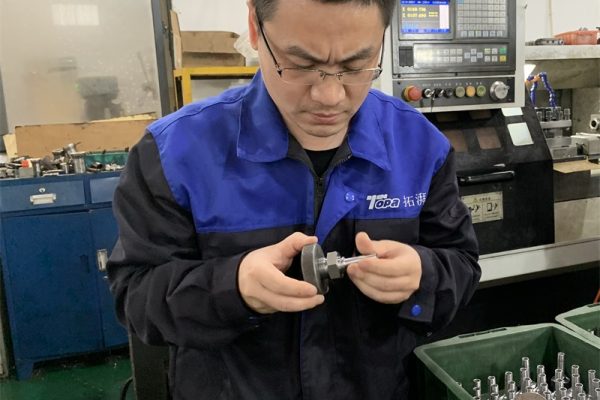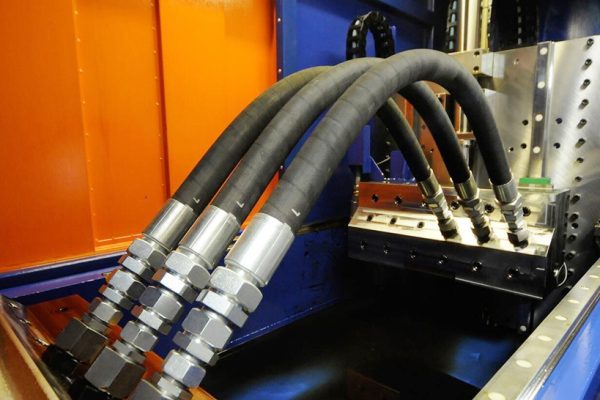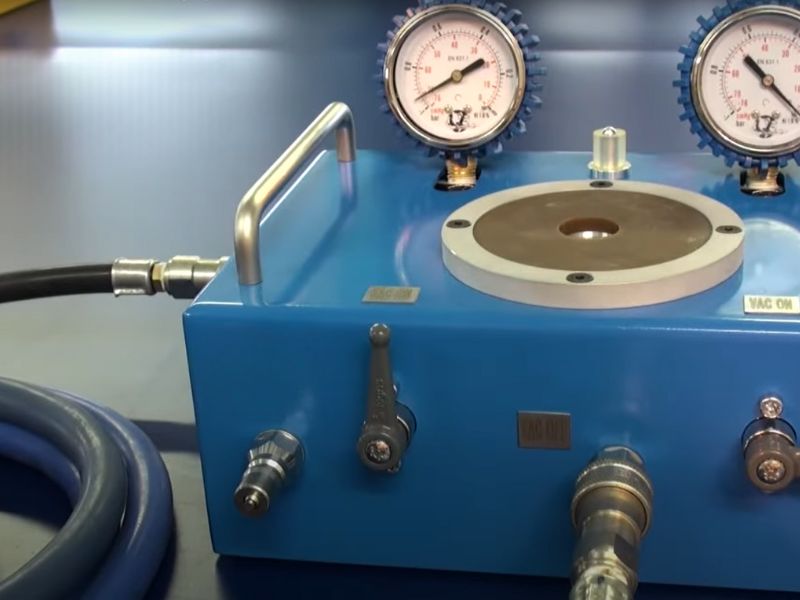In the realm of hydraulic systems, the integrity of hoses and fittings is non-negotiable for ensuring operational safety and efficiency. This introduction delves into the basic testing methods essential for evaluating the performance and durability of hydraulic hoses and fittings. By adhering to standardized testing protocols, one can significantly mitigate the risks associated with hydraulic system failures.
Hydraulic hose and fitting testing is a crucial process in the maintenance and operation of hydraulic systems. It consists of several inspections and tests to ensure these components can endure the operational demands they will face. This section elaborates on the process, its importance, and the standards guiding these tests.
Testing hydraulic hoses and fittings is essential for several reasons:
Safety: The primary concern in hydraulic systems is the safety of the operators and the environment. A failure in a hydraulic hose or fitting can lead to high-pressure leaks or bursts, potentially causing injuries or environmental damage.
System Efficiency and Reliability: Proper testing ensures that every component in a hydraulic system operates within its intended specifications, leading to a more efficient and reliable system overall.
Cost-Efficiency: By identifying potential failures before they occur, testing can save costs associated with downtime, repairs, and replacements.
Adhering to industry standards and certifications is not just a regulatory requirement; it’s a benchmark for quality and safety. Two of the most recognized standards in hydraulic system components testing are:
SAE (Society of Automotive Engineers): SAE sets global standards for engineering professionals in various industries, including automotive, aerospace, and commercial vehicles. For hydraulic hoses and fittings, SAE standards cover aspects like dimensions, performance, and testing methodologies.
ISO (International Organization for Standardization): ISO standards are internationally agreed upon by experts to ensure quality, safety, and efficiency. ISO standards for hydraulic hoses and fittings cover similar aspects to SAE but are recognized and followed globally.
Testing hydraulic hoses and fittings is essential for ensuring the safety and efficiency of hydraulic systems. These tests simulate operational conditions to verify that components can perform as required.
Visual inspection serves as the foundational step in the testing and maintenance regimen for hydraulic hoses and fittings, emphasizing the importance of early detection in preventing system failures. This proactive approach ensures that potential issues are identified and addressed before they escalate into more significant problems that could disrupt system operation, lead to downtime, or cause safety hazards. The process of visual inspection includes several key checks:
Inspectors look for any signs of surface wear, such as cracks and abrasions on the hose’s outer cover. These defects can compromise the hose’s structural integrity, making it susceptible to further damage and eventual failure. Surface wear often indicates material degradation, which can be caused by environmental factors such as ultraviolet (UV) light, ozone, extreme temperatures, or chemical exposure. Early detection of these signs allows for timely replacement of the hose, preventing leaks or bursts under pressure.

The presence of fluid leakage, especially around fittings, is a clear indicator of potential issues. Leaks can result from improper installation, such as incorrect tightening of fittings, or from seal failure, which may be due to material incompatibility or wear. Identifying leaks early helps prevent fluid loss, which can compromise the hydraulic system’s efficiency and lead to environmental contamination or safety risks.
Fittings that are bent, corroded, or otherwise damaged pose a significant risk to the connection’s integrity between the hose and the hydraulic system. Damage to fittings can result from mechanical impact, corrosion due to chemical exposure, or general wear and tear. Such defects can impair the fitting’s ability to maintain a secure and leak-free connection, necessitating their inspection and replacement to ensure system reliability.
Deformations such as kinking or twisting of the hose can severely impede fluid flow, potentially leading to pressure build-ups and the risk of hose burst. Kinking is often the result of improper hose routing or installation, while twisting can occur if the hose is not correctly aligned with the fitting during installation. These issues not only affect system performance but can also shorten the hose’s lifespan.
Pressure testing is an indispensable component of the evaluation process for hydraulic hoses and fittings, aimed at validating their capacity to handle designated operational pressures without compromise. This testing is bifurcated into static and dynamic pressure testing, each addressing different aspects of a component’s pressure resilience.
Static pressure testing is a straightforward yet critical test where a constant pressure is applied to the hydraulic hose and fittings for a predetermined period. The primary objectives of this test are to:
Ensure Integrity: The test confirms that the hose and fittings can hold the applied pressure without any form of degradation, such as leaks or bursts.
Validate Design Specifications: It verifies that the components meet the pressure requirements as per their design specifications, ensuring they are suitable for their intended operational environment.
Detect Weak Points: Any potential weaknesses in the hose assembly, including issues with the hose itself or the crimping quality of the fittings, are identified under controlled conditions rather than in the field.
This form of testing is crucial for components expected to operate under constant pressure levels during their service life, providing a baseline assurance of their capability to perform as required.
Dynamic pressure testing takes the evaluation a step further by simulating the pressure fluctuations that hydraulic hoses and fittings would encounter in real-world operations. This test is essential for several reasons:
Replicates Operational Conditions: It mimics the varying pressures that occur during the normal operation of hydraulic systems, offering a more realistic assessment of component performance.
Evaluates Endurance: By subjecting the components to cycles of pressurization and depressurization, the test assesses their ability to endure repetitive stress, which is critical for dynamic applications.
Identifies Fatigue Resistance: The test highlights the hose and fittings’ resistance to fatigue, ensuring they do not fail prematurely under cyclic loading conditions.
Dynamic pressure testing is particularly relevant for hydraulic systems in mobile equipment and machinery, where the hydraulic components are subjected to constant variations in pressure due to the operational demands of the system.

Burst testing is a pivotal process in assessing the strength and reliability of hydraulic hoses and fittings, providing essential data on their maximum pressure capacity before failure. This test is integral to establishing the safety margins for hydraulic components, ensuring that they are robust enough to handle unexpected surges in pressure without catastrophic failure. The methodology and significance of burst testing are outlined below:
Incremental Pressure Increase: The test involves subjecting the hydraulic hose or fitting to increasing pressures until the component ultimately fails. This incremental approach allows for the precise determination of the failure point.
Controlled Environment: Burst testing is conducted in a controlled environment to ensure the safety of personnel and to accurately measure the pressure at which failure occurs.
Failure Analysis: The point of failure provides critical insights into the component’s structural integrity and the effectiveness of the material and design used. Analyzing the mode of failure can also inform improvements in future designs.
Safety Margins: By determining the maximum pressure a component can withstand, engineers can establish safety margins that guide the operational pressure limits. This ensures that hydraulic systems are designed with a buffer to prevent components from being operated near their failure point.
Quality Assurance: Burst testing is a crucial aspect of quality assurance for hydraulic components, confirming that they meet the high standards required for safe and effective operation.
Regulatory Compliance: Many industries have regulatory requirements for the minimum burst pressure for hydraulic hoses and fittings. Burst testing ensures compliance with these regulations, avoiding the risks of fines or operational shutdowns.
System Design: The data obtained from burst testing are instrumental in the hydraulic system design process, allowing engineers to select components that provide the best balance between performance, cost, and safety.
Flex impulse testing is a specialized evaluation aimed at ensuring hydraulic hoses can endure the dual stresses of flexing movements and impulse pressures, which are common in many hydraulic system applications. This test is particularly relevant for dynamic systems where hoses are expected to operate under constant movement and pressure variations, such as in mobile machinery, construction equipment, and industrial automation systems.
Simulated Operational Stresses: The test simulates the operational conditions a hose would experience in a real-world setting by subjecting it to repeated flexing and pressure pulses. This dual simulation is crucial for assessing the hose’s performance under conditions that mimic actual use.
Cycling Between Flexed Positions: The hose is moved between different flexed positions under pressure, which tests the hose’s flexibility and strength simultaneously. This action replicates the constant movements and adjustments typical in hydraulic systems.
Pressure Impulses: Along with flexing, the hose is also subjected to impulse pressures, sudden and extreme variations in pressure that test the resilience of the hose’s structure and material composition. These impulses are critical for assessing how well the hose can handle spikes in pressure without failure.
Durability Assessment: This test provides valuable data on the durability and expected lifespan of hydraulic hoses under flexing and impulse conditions. By understanding how a hose will perform over time, manufacturers and users can make informed decisions about hose selection and system design.
Preventing Premature Failures: Flex impulse testing helps identify potential weaknesses in hose designs, materials, or manufacturing processes that could lead to premature failure when subjected to dynamic stresses. This early detection allows for adjustments in design or material selection to enhance hose performance and reliability.
Design Optimization: The results from flex impulse testing are instrumental in the design and development of hoses intended for dynamic applications. They allow engineers to optimize hose construction, selecting materials and designs that offer the best performance under flexing and impulse stresses.
Safety and Efficiency: By ensuring that hydraulic hoses can withstand the conditions they’ll face in operation, flex impulse testing contributes to the overall safety and efficiency of hydraulic systems. It helps prevent leaks, bursts, and system failures that could result in downtime, costly repairs, or safety hazards.
Vacuum testing is a critical assessment for hydraulic hose assemblies, focusing on their ability to maintain integrity under negative pressure conditions. This test is essential for applications where hoses are expected to either sustain a vacuum or are at risk of collapse due to external pressures.
Application of Vacuum: A vacuum is applied to the interior of the hose assembly to create negative pressure conditions. This mimics the operational environment for hoses used in vacuum applications or those exposed to external pressures higher than the internal pressure.
Monitoring for Leaks: While the vacuum is maintained, the hose and fittings are closely monitored for signs of leakage. The presence of leaks would indicate a compromised seal or flaws in the hose material or fitting connections.
Assessing Structural Integrity: The test also evaluates the structural integrity of the hose under vacuum conditions. It checks for any deformation, such as collapsing or buckling, which could impede fluid flow or cause a failure in service.

Ensuring Sealing Capabilities: Vacuum testing verifies the effectiveness of the sealing mechanisms between the hose and fittings, ensuring that the assembly can maintain a secure seal under negative pressure. This is crucial for preventing air ingress, which could affect system performance or contaminate the fluid being transported.
Preventing Hose Collapse: For hoses that operate under vacuum or are subjected to higher external pressures, the test ensures that the hose material and design are robust enough to prevent collapse. A hose collapse could lead to blockages, affecting the efficiency and safety of the hydraulic system.
Identifying Potential Failures: By identifying weak points in hose assemblies under vacuum conditions, this test helps in preempting failures that could lead to system downtime or safety hazards. Early detection of such issues allows for corrective measures before the components are put into operation.
Application-Specific Testing: Vacuum testing is particularly relevant for industries and applications where vacuum conditions are prevalent, such as in material handling, chemical processing, and certain manufacturing processes. It ensures that hose assemblies are fit for purpose, offering reliability and performance suited to specific operational needs.
Compatibility testing is a fundamental aspect of assessing hydraulic hose and fitting suitability for specific applications, especially concerning the hydraulic fluids they will encounter. This testing is crucial for ensuring that the materials composing the hoses and fittings do not adversely react when exposed to various hydraulic fluids under operational conditions.
Immersion of Components: The core of compatibility testing involves immersing hoses and fittings in the hydraulic fluid they are expected to carry. This immersion is conducted at temperatures that replicate the operational environment to accurately simulate real-world conditions.
Observation Period: After immersion, the components are observed over a set period. This duration allows for the identification of any slow-reacting chemical interactions that might not be immediately apparent.
Evaluation of Effects: The key outcomes evaluated include changes in the material’s properties such as swelling, hardening, cracking, or degradation. Any of these changes could compromise the integrity of the hose or fitting and, by extension, the safety and efficiency of the hydraulic system.
Preventing Material Degradation: Compatibility testing ensures that the materials used in hoses and fittings are resistant to degradation when exposed to hydraulic fluids. This is crucial for maintaining the structural integrity of these components throughout their operational life.
Avoiding Swelling and Cracking: Certain materials may swell or crack upon exposure to specific chemicals in hydraulic fluids. Compatibility testing identifies these risks, ensuring that selected materials will remain stable and functional.
Ensuring System Reliability: By verifying the compatibility of hoses and fittings with the hydraulic fluids, this testing helps in maintaining the overall reliability of the hydraulic system. It prevents leaks, ruptures, and failures that could arise from incompatible material-fluid interactions.
Supporting Safe Operations: The safety of hydraulic systems is paramount, and compatibility testing plays a vital role in preventing accidents and leaks that could pose risks to operators and the environment. By ensuring materials are chemically compatible with the fluids they will carry, the risk of hazardous leaks or bursts is significantly reduced.
Optimizing Performance: Beyond safety and reliability, compatibility testing is essential for optimizing the performance of hydraulic systems. Components that are compatible with the hydraulic fluids they use can maintain their designed efficiency and functionality, supporting the system’s overall performance.
Interpreting the results of hydraulic hose and fitting tests is a crucial step in ensuring the safety, efficiency, and reliability of hydraulic systems. The outcomes of these tests provide valuable insights into the performance characteristics and limitations of the components. Understanding how to analyze these results, including the implications of various failure modes, is essential for determining the usability and safety margins of hoses and fittings. This process involves several key considerations:
Compliance with Standards: Test results should first be compared against industry standards, such as those set by ISO and SAE. Compliance with these standards ensures that hoses and fittings meet minimum safety and performance criteria.
Performance Benchmarks: Results should also be evaluated against manufacturer specifications and performance benchmarks. This comparison can identify any discrepancies between expected and actual performance levels.
Identifying Weak Points: The nature and conditions of test failures can pinpoint specific weaknesses in hoses and fittings. For instance, a failure during burst testing might indicate a material flaw or design limitation.
Material and Design Evaluation: Analyzing failure modes helps in assessing the suitability of materials and design choices for specific applications. This analysis can lead to design improvements or material changes to enhance component performance and safety.
Establishing Safety Margins: Test results, especially from burst and impulse testing, help establish safety margins. These margins indicate the difference between operational pressures and the point at which failure occurs, providing a buffer to ensure safe operation.
Operational Life Expectancy: The results from flex impulse and compatibility testing can inform decisions on the operational life expectancy of hoses and fittings. Understanding how these components degrade over time or under specific conditions allows for more accurate maintenance and replacement schedules.
Environmental and Chemical Suitability: Compatibility testing results are particularly important for determining which hydraulic fluids are safe to use with specific hoses and fittings. This ensures that components are not subjected to environments that could accelerate wear or cause premature failure.
In conclusion, the basic testing methods for hydraulic hoses and fittings are crucial for maintaining effective and safe hydraulic systems. These tests, guided by established protocols and standards, are essential for assessing the reliability, durability, and safety of hydraulic components. By diligently applying these tests, the hydraulic industry can continue to advance, providing systems that meet the ever-increasing demands of modern applications while ensuring the safety of operators and the environment. The commitment to rigorous testing is a commitment to excellence, underscoring the critical role of these procedures in the lifecycle of hydraulic systems.